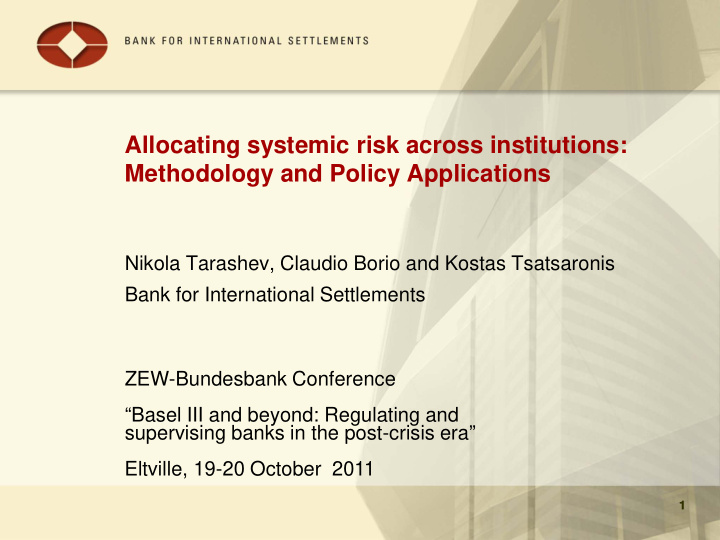



Allocating systemic risk across institutions: Methodology and Policy Applications Nikola Tarashev, Claudio Borio and Kostas Tsatsaronis Bank for International Settlements ZEW-Bundesbank Conference “Basel III and beyond: Regulating and supervising banks in the post-crisis era” Eltville, 19-20 October 2011 1 1
Focus on the system Key lesson from crisis: • Emphasis on the system • Policy objective to mitigate systemic risk • “Macroprudential” approach Many prudential tools are institution-specific Instruments need to be calibrated on the basis of individual firm’s contribution to system-wide risk 2
Disclaimer The views expressed here are my own and not necessarily those of the Bank for International Settlements or the Basel Committee on Banking Supervision 3
Contributions of this paper Propose an allocation procedure of systemic risk to individual institutions based on the “Shapley Value” • Efficient, fair, general and robust Use the procedure to illustrate the relative importance of different drivers of system-wide risk • Size, individual risk and interconnectedness Use it to demonstrate how policy tools can be designed to deal with the externalities of systemic importance • Macroprudential tools 4
Allocating systemic risk: Shapley value The Shapley value methodology has one requirement: • a characteristic function, which … • … maps any subgroup of institutions into a measure of risk The Shapley value of an institution = its average contribution to the risk of all subgroups of institutions in the system . Degree of systemic importance = Shapley value 5
Simple example with the Shapley value Three players: A, B and C 6
Why Shapley value? Efficient: allocates total quantity of risk exactly Fair: allocates risk according to contributions • Includes all bilateral links Flexible: can be applied to any portfolio measure of system-wide risk Robust to model uncertainty: allocations corresponding to different models can be combined in a straight forward (linear) way to produce robust estimate of systemic contribution 7
Application using Expected Shortfall Define system-wide risk as the credit risk on the combined portfolio of liabilities of “banks” in the system • Think of the deposit insurer’s problem Expected Shortfall as the risk metric • Expected loss in the tail Used single-factor default mode model • A bank pays back or defaults and pays 1-LGD 8
Application using Expected Shortfall Use two different value functions • Constant conditioning event, like in Acharya et al (2009) and Huang, Zhao, Zhu (2009) • Conditioning event dependent on the identity of the coalition Results are not identical but technology is equally applicable 9
Different drivers of systemic importance Drivers considered: size, PD, exposure to common factor No single driver explains satisfactorily systemic importance … 10
The impact of PD and common-factor exposure Intuitive results An increase in the PD raises systemic importance Higher exposure to the common factor … • … implies that the bank is more likely to fail with others • raises systemic importance 11
Interaction between different drivers Changes in PD have a greater impact on the systemic importance of institutions that are more exposed to the common factor … 12
Impact of size Ceteris paribus systemic importance increases at least proportionately with size of the institution 13
Size: a convex impact on systemic importance 14
Impact of size Ceteris paribus systemic importance increases at least proportionately with size of the institution Theorem: • Two banks {B,S} that are identical except for size • B is larger than S • ShV( B ) / ShV( S ) > size of ( B) / size of (S ) 15
Impact of size Ceteris paribus systemic importance increases at least proportionately with size of the institution Intuition: larger banks appear more often in tail events • ES is the expected loss conditional on being at the tail • For each tail event that includes S there must be another that includes the same group of banks and B instead of S Proof is possible because of Shapley Value structure 16
Policy intervention: “macro” vs “micro” Objective of the intervention • Attain a given level of systemic risk • Equalise systemic importance across institutions, controlling for institutions’ sizes Stylised system (mechanical application) • Higher capital lower PD 17
Policy intervention: concrete example “Efficiency” result: greater loading on systematic risk implies that a given change in capital (ie PD) has a greater impact on systemic importance Opposite outcome also possible, if there are more interactions … 18
Banks that differ only in size Capital Capital charge charges that combinations equate that result in Minimum contributions target level of total capital to system- system-wide combinations wide risk risk Equal capital charges to both institutions 19
Banks that differ in size and correlation Capital charges that equate contributions to system- wide risk Equal capital charges to both institutions 20
Conclusions Shapley methodology provides a neat way to allocate risk • Flexibility and robustness Attribution of risk needs to look at all drivers and interactions • Importance of models • Size has a non-linear effect Macroprudential policy can lead to re-allocation of capital 21
Thank you! Kostas Tsatsaronis ktsatsaronis@bis.org 22
Recommend
More recommend